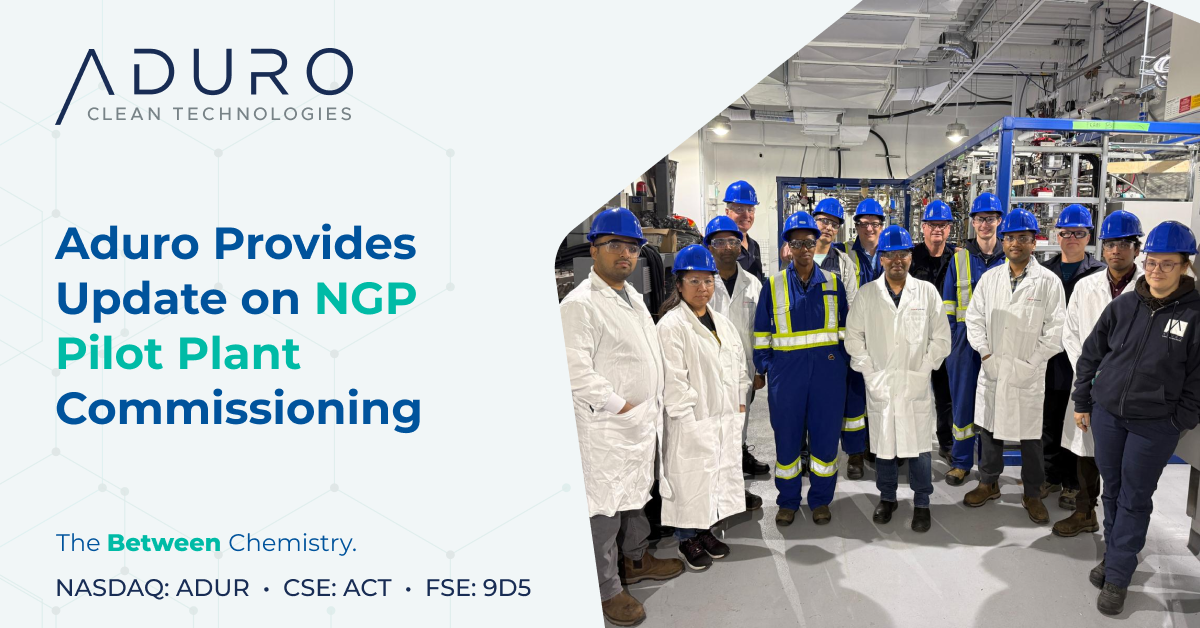Aduro Clean Technologies (Nasdaq: ADUR) moves NGP Pilot to Phase 2; SAT/FAT completed – Stock Titan

Aduro Clean Technologies NGP Pilot Plant: Commissioning Update and Alignment with Sustainable Development Goals
Project Overview and Strategic Contribution to Sustainability
On October 30, 2025, Aduro Clean Technologies Inc. (Nasdaq: ADUR) reported significant progress in the commissioning of its Next Generation Process (NGP) Pilot Plant in London, Ontario. The project has advanced from Phase 1 (Assembly and Installation) to Phase 2 (Integrated Operations and Process Tuning). This development is a critical step in validating the company’s patented Hydrochemolytic technology, which is designed to convert low-value feedstocks such as waste plastics, heavy bitumen, and renewable oils into valuable resources. The initiative directly supports the global transition towards a circular economy and sustainable industrial practices.
technology, which is designed to convert low-value feedstocks such as waste plastics, heavy bitumen, and renewable oils into valuable resources. The initiative directly supports the global transition towards a circular economy and sustainable industrial practices.
Alignment with UN Sustainable Development Goals (SDGs)
The NGP Pilot Plant project and its underlying technology make substantial contributions to several key UN Sustainable Development Goals:
- SDG 9: Industry, Innovation, and Infrastructure: The plant represents a first-in-kind implementation of an innovative chemical process. By developing and scaling this technology, Aduro is building resilient infrastructure and promoting inclusive and sustainable industrialization.
- SDG 12: Responsible Consumption and Production: The core mission of the Hydrochemolytic
 technology is to create sustainable production patterns by chemically recycling waste plastics. This addresses the global plastic waste crisis and promotes a circular economy, turning waste into a resource.
technology is to create sustainable production patterns by chemically recycling waste plastics. This addresses the global plastic waste crisis and promotes a circular economy, turning waste into a resource. - SDG 7: Affordable and Clean Energy: The technology’s capability to upgrade heavy crude, bitumen, and renewable oils into higher-value fuels supports the goal of ensuring access to affordable, reliable, and sustainable energy.
- SDG 11: Sustainable Cities and Communities: By providing a scalable solution for plastic waste, the technology helps mitigate a major challenge for urban centers, reducing landfill dependency and pollution.
- SDG 13: Climate Action: The process offers a lower-temperature alternative for chemical recycling and resource upgrading, which can support efforts to combat climate change by creating more efficient value chains for waste and energy feedstocks.
Phase 2 Commissioning Milestones and Technical Progress
The transition to Phase 2 commissioning was enabled by the achievement of several critical technical milestones, which validate the plant’s readiness for integrated operations. These milestones are foundational for generating the data needed to scale this sustainable technology.
- Installation of Core Systems: All major modules, including the extruder, Zeton-fabricated process skids, and the Siemens automation network, have been installed at the facility.
- Completion of Acceptance Testing:
- The extruder successfully completed its Site Acceptance Testing (SAT).
- The modular process skids, fabricated by Zeton Inc., passed Factory Acceptance Testing (FAT) prior to delivery.
- Automation and System Integration: Siemens Canada has completed the configuration of the automation, control, and communication systems, integrating all primary equipment into a unified control network.
- Commencement of Integrated Testing: Current activities are focused on sequential testing, wet runs, and process tuning, which will continue through mid-December 2025.
Future Outlook and Impact on Sustainable Commercialization
The successful commissioning of the NGP Pilot Plant is a strategic imperative for Aduro’s path to commercialization. The data generated during the upcoming extended operation campaigns will be instrumental in achieving future sustainability objectives.
- Data for Scale-Up: The plant will provide critical data on mass/energy balances, yields, and process controllability. This information is essential for the design and engineering of the planned 8,000 tons-per-year demonstration plant.
- Validation of Environmental Benefits: Operational data will support comprehensive lifecycle analyses and environmental assessments, quantifying the technology’s contribution to SDG 12 and SDG 13.
- Operator Training and Procedure Development: The commissioning phase includes the development of standardized operating procedures and operator training, ensuring safe and efficient readiness for continuous, commercial-scale operations that advance the circular economy.
Analysis of Sustainable Development Goals (SDGs) in the Article
1. Which SDGs are addressed or connected to the issues highlighted in the article?
-
SDG 7: Affordable and Clean Energy
- The article mentions Aduro’s technology is used to “transform renewable oils into higher-value fuels.” This directly relates to the development of cleaner energy sources. The conversion of “heavy crude and bitumen into lighter, more valuable oil” also points to creating more efficient energy products.
-
SDG 9: Industry, Innovation, and Infrastructure
- The entire article focuses on the commissioning of a “Next Generation Process (NGP) Pilot Plant,” which is a prime example of industrial innovation. The development and implementation of the patented “Hydrochemolytic
 Technology” represents an advancement in clean technology and sustainable industrial processes.
Technology” represents an advancement in clean technology and sustainable industrial processes.
- The entire article focuses on the commissioning of a “Next Generation Process (NGP) Pilot Plant,” which is a prime example of industrial innovation. The development and implementation of the patented “Hydrochemolytic
-
SDG 11: Sustainable Cities and Communities
- The technology’s capability to “chemically recycle waste plastics” addresses a critical urban challenge: waste management. By converting plastic waste into valuable resources, it contributes to reducing the environmental footprint of cities and moving towards a circular economy.
-
SDG 12: Responsible Consumption and Production
- This is a central theme of the article. Aduro’s technology is designed to “transform lower value feedstocks, like waste plastics… into resources for the 21st century.” This directly supports the principles of reducing waste and promoting recycling and reuse, which are core to sustainable production patterns.
2. What specific targets under those SDGs can be identified based on the article’s content?
-
Under SDG 7 (Affordable and Clean Energy):
- Target 7.a: “By 2030, enhance international cooperation to facilitate access to clean energy research and technology… and promote investment in energy infrastructure and clean energy technology.” The article highlights the collaboration between Aduro, Zeton Inc., and Siemens Canada to develop and commission this new clean technology plant, reflecting investment and cooperation in the sector.
-
Under SDG 9 (Industry, Innovation, and Infrastructure):
- Target 9.4: “By 2030, upgrade infrastructure and retrofit industries to make them sustainable, with increased resource-use efficiency and greater adoption of clean and environmentally sound technologies and industrial processes…” The NGP Pilot Plant is a direct effort to adopt a “clean and environmentally sound technology” (Hydrochemolytic
 ) to improve resource efficiency by converting waste into valuable products.
) to improve resource efficiency by converting waste into valuable products.
- Target 9.4: “By 2030, upgrade infrastructure and retrofit industries to make them sustainable, with increased resource-use efficiency and greater adoption of clean and environmentally sound technologies and industrial processes…” The NGP Pilot Plant is a direct effort to adopt a “clean and environmentally sound technology” (Hydrochemolytic
-
Under SDG 11 (Sustainable Cities and Communities):
- Target 11.6: “By 2030, reduce the adverse per capita environmental impact of cities, including by paying special attention to air quality and municipal and other waste management.” The technology’s function to “chemically recycle waste plastics” directly contributes to improving municipal waste management systems.
-
Under SDG 12 (Responsible Consumption and Production):
- Target 12.5: “By 2030, substantially reduce waste generation through prevention, reduction, recycling and reuse.” The core purpose of Aduro’s technology described in the article is the chemical recycling of waste plastics, which is a key strategy for achieving this target.
3. Are there any indicators mentioned or implied in the article that can be used to measure progress towards the identified targets?
-
Indicator for Target 9.4 and 12.5:
- The article states that data from the pilot plant will “inform the design basis and integration approach for the previously announced demonstration plant with an initial capacity of 8,000 tons per year.” This figure (8,000 tons/year) serves as a specific, measurable indicator of the potential scale of waste recycling and the adoption of this clean technology.
-
Indicator for Target 9.4:
- The article mentions that the pilot plant will “confirm mass and energy balances, yields, and controllability.” These metrics are direct indicators of resource-use efficiency. Data on yields and energy balance can be used to quantify the sustainability and efficiency of the new industrial process compared to traditional methods.
-
Indicator for Target 7.a and 9.4:
- The development and commissioning of the “NGP Pilot Plant” itself is an indicator of investment in clean technology research and infrastructure. The successful progression from “Phase 1 to Phase 2 commissioning” marks tangible progress in making this technology operational.
4. Summary Table of SDGs, Targets, and Indicators
| SDGs | Targets | Indicators |
|---|---|---|
| SDG 7: Affordable and Clean Energy | 7.a: Promote access to research, technology, and investment in clean energy. | Development and commissioning of the NGP Pilot Plant through partnerships (Zeton, Siemens) as an investment in clean technology. |
| SDG 9: Industry, Innovation, and Infrastructure | 9.4: Upgrade infrastructure and industries for sustainability and increased resource-use efficiency with clean technologies. | Collection of data on “mass and energy balances, yields, and controllability” to measure resource efficiency. |
| SDG 11: Sustainable Cities and Communities | 11.6: Reduce the environmental impact of cities, particularly in waste management. | The technology’s application to “chemically recycle waste plastics,” addressing municipal waste challenges. |
| SDG 12: Responsible Consumption and Production | 12.5: Substantially reduce waste generation through recycling and reuse. | Planned capacity of the future demonstration plant: “8,000 tons per year” of processed feedstock (e.g., waste plastics). |
Source: stocktitan.net
What is Your Reaction?
 Like
0
Like
0
 Dislike
0
Dislike
0
 Love
0
Love
0
 Funny
0
Funny
0
 Angry
0
Angry
0
 Sad
0
Sad
0
 Wow
0
Wow
0



















































.jpg.webp?itok=0ZsAnae9#)

























